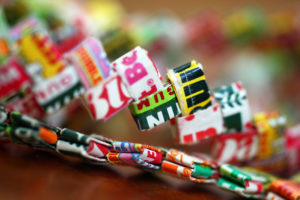
In 1970, I turned six years old. I had two older sisters: Jayne – who was just starting high school – was 15, and Susan was 18, having just graduated high school, was looking forward to college. I was raised in a “crafty” family with sisters who made gum wrapper chains from Juicy Fruit wrappers and God’s eyes with colored yarn and dowels. Christmas usually begat gifts of Shrinky Dinks and string art kits. We had a mother who – the product of the 1950s – would routinely sew all of us girls dresses and nightgowns reminiscent of Laura Ingalls Wilder with brimmed, gingham Holly Hobby bonnets. I remember one Christmas getting two nightgowns – one white with yellow flowers and the other yellow with white flowers – with a reversible bonnet to be worn with either nighty.
Birthdays were sumptuous affairs where Mom would work hard on whatever desired theme cake was requested and I do remember her attempt at an ill-advised peanut butter-and-jelly cake. But mostly I remember her Easter cakes, made in the shape of a rabbit, covered with shredded coconut for the fur, and a beguiling face piped out in frosting. I don’t think she had a rabbit mold for the cake. I believe she took the time to cook several sheet cakes and cut out the desired bunny form. Because of my sisters’ advanced years (compared to me) and the fact that Susan didn’t live with us for much more than my earliest years, I have very distinct memories of the late 60s and early 70s. It was an era of cocktail parties (“Yes, Carrie, you can have one more rumaki and then off to bed!”), Saturday morning cartoons (I wanted the pink butterfly dress worn by the only girl bug, Joy, in Sid and Marty Krofft’s The Bugaloos), and crafts. Crafts were prevalent as Flower Children were breaking away from the establishment and returning to a simpler time. I turned my Disney record player into a potter’s wheel. We made homemade sand candles. I was taught to crochet, embroidery, and – most importantly – macramé.
Macramé is a textile technique involving stranded fiber – usually jute – that is knotted into patterns and forms. In the 1970s, macramé was the craft fad that swept the nation. Unlike knitting or crochet, it needs no tools and is all done by hand. The art originated in the thirteenth century by Arabic weavers who knotted the excess thread along the edges of woven fabric into decorative fringes. Their word, migramah, is the genesis for the word, macramé. As sailing and shipping rose during the fourteenth and fifteenth centuries, it was undoubtedly the seafarers, who were already adept at tying their seaman’s knots, who spread the technique. And in 1970s, we Tillie family were just as smitten as the rest of the United States with the craft. We made macramé wall-hangings, belts, and purses. The step-by-step books of macramé instruction by Golden Press, Sunset Books, and the Time Life, were cherished, dog-eared, and often hidden by my sisters so that I couldn’t find them.
And then came the time when I was taken on a holiday road trip from California to Washington. Besides the usual find-a-word books to keep me busy in the back seat, I somehow had the brilliant idea of using red licorice laces to macramé bracelets. Using a toothpick, I pushed a whole through colored gumdrops for beads on my edible macramé creations. I’m sure my family appeased me by wearing my bracelets until they would either be eaten or thrown away, but I have a visceral and distinct memory of pride in the weaving of knots into chewy adornment. I seven or eight years old, but I had turned my love of crafts into the first form of food art I can remember making.